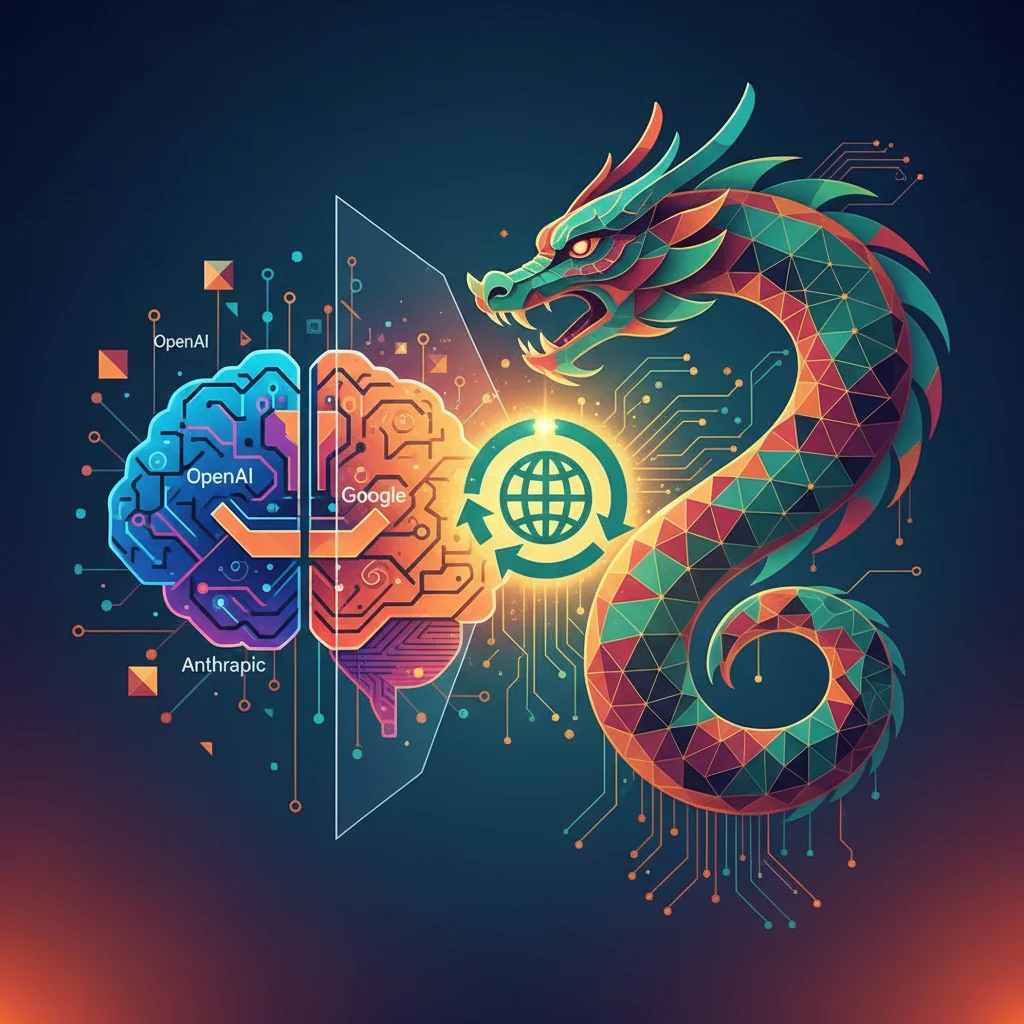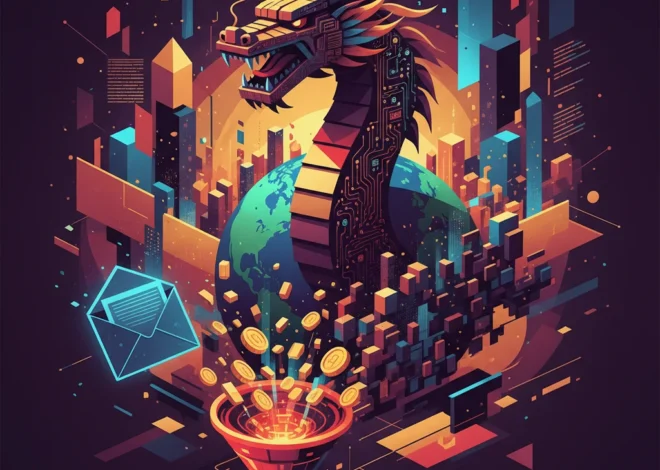
The AI Cold War: How China is Quietly Winning the Open-Source Revolution
In the glowing arena of artificial intelligence, the spotlight has been firmly fixed on a handful of American titans. Names like OpenAI, Google, and Anthropic have become synonymous with the AI revolution, captivating the world with their powerful, yet tightly guarded, “closed” models like GPT-4 and Gemini. It’s a story of massive investment, proprietary code, and a business model built on selling access through the cloud. But while we’ve been watching the main event, a dramatic new chapter has been unfolding in the shadows—and it’s a story that could redefine the future of AI.
A strategic pivot is underway, and it’s being led by China. While American giants build higher walls around their digital kingdoms, Beijing-backed technology companies are aggressively championing an “open” approach. They are releasing powerful, sophisticated AI models for the world to use, modify, and build upon. And according to a recent analysis by the Financial Times, they aren’t just participating—they’re starting to dominate.
This isn’t just a technical debate about programming philosophy; it’s a geopolitical gambit with profound implications for developers, startups, and the global balance of technological power. Let’s unravel the tale of two AIs and explore why this shift matters more than you think.
The Great Divide: Open-Source vs. Closed-Source AI
At the heart of this story is a fundamental schism in the world of software development, now playing out on the grand stage of artificial intelligence. Understanding this divide is crucial to grasping the strategic chess match between the US and China.
The Walled Gardens of Closed-Source AI
Think of closed-source AI as a Michelin-starred restaurant. You can enjoy the exquisite meal (the AI’s output), but you’re not allowed in the kitchen. The recipe, the ingredients, and the techniques are all trade secrets. Companies like OpenAI, Google, and Anthropic have invested billions in developing their large language models (LLMs). To recoup this investment and maintain a competitive edge, they keep the model’s architecture, training data, and source code under lock and key.
The Business Model: Access is typically sold as a service (SaaS) via an API (Application Programming Interface). Developers pay per query or on a subscription basis to integrate this powerful AI into their own applications. It’s a centralized, controlled, and highly profitable approach.
The Pros:
- Control & Safety: The creators can monitor usage, prevent misuse, and implement safety filters directly.
- Performance: They often represent the absolute cutting edge of AI capability due to concentrated R&D efforts.
- Ease of Use: Developers don’t need to worry about the underlying infrastructure; they just call the API.
The Cons:
- The “Black Box” Problem: You don’t know exactly how the model works, what biases it might have, or what data it was trained on.
- Vendor Lock-In: Your entire product becomes dependent on a single provider. If they raise prices or change their terms, you have little recourse.
- Cost: Scaling an application on a closed API can become prohibitively expensive.
The Collaborative Frontier of Open-Source AI
Open-source AI is the community potluck. The recipe is shared publicly. Anyone can see what went into it, suggest improvements, and even take the recipe home to create their own version. Companies like Meta (with its Llama models) and France’s Mistral have been major Western players, but Chinese tech firms are now flooding the space.
In this model, the source code and model weights are released for free. Developers can download, run, and fine-tune these models on their own hardware or cloud instances. This fosters a decentralized ecosystem of innovation.
The Pros:
- Transparency & Customization: Developers can inspect the code and tailor the model for specific tasks, leading to more efficient and specialized applications.
- Lower Cost: Eliminates API fees, with costs shifting to your own computing infrastructure.
– Innovation & Competition: It democratizes access to powerful technology, allowing startups and researchers to compete and build new solutions without massive upfront investment.
The Cons:
- Cybersecurity & Misuse: Without centralized control, there’s a higher risk of models being used for malicious purposes, from generating misinformation to creating malware.
- Complexity: Requires more technical expertise to deploy and manage the infrastructure.
- Fragmented Support: You rely on community support rather than a dedicated corporate helpdesk.
The Day the Internet Stumbled: What the Cloudflare Outage Reveals About Our Digital World
China’s Strategic Leapfrog
For months, leaderboards on Hugging Face—a key hub for the open-source machine learning community—have been telling a startling story. Models developed by Chinese companies are consistently ranking at or near the top, outperforming many Western counterparts in various benchmarks. As the FT notes, models like Alibaba’s Qwen and 01.AI’s Yi have become standout performers, gaining significant traction among global developers (source).
This is not a coincidence; it’s a calculated strategy. Facing US sanctions on advanced semiconductor chips, which are crucial for training the largest AI models from scratch, China has found a clever workaround. By open-sourcing slightly smaller but still potent models, they shift the computational burden to the global community. Fine-tuning an existing open-source model requires far less computing power than training a frontier model like GPT-4. This approach allows China to sidestep the hardware bottleneck and rapidly build a global ecosystem around its technology.
Here’s a look at how the AI landscape is split, featuring some of the key players in this new global competition:
| Model Name | Developer | Country | Primary Strategy |
|---|---|---|---|
| GPT-4 / GPT-4o | OpenAI | USA | Closed-Source (API Access) |
| Gemini 1.5 Pro | USA | Closed-Source (API Access) | |
| Claude 3 | Anthropic | USA | Closed-Source (API Access) |
| Llama 3 | Meta | USA | Open-Source |
| Qwen 2 | Alibaba | China | Open-Source |
| Yi-Large | 01.AI | China | Open-Source |
| GLM-4 | Zhipu AI | China | Open-Source |
This strategy allows Chinese firms to gain invaluable feedback, data, and improvements from a global pool of developers, accelerating their models’ evolution at a blistering pace. They are effectively crowdsourcing their R&D and global market penetration.
Your Wallet, Now Powered by ChatGPT: Inside the Landmark OpenAI and Intuit Deal
What This Means for the Tech World
This global shift has immediate and tangible consequences for everyone in the technology space, from individual programmers to billion-dollar enterprises.
For Developers and Programmers
The rise of high-quality open-source AI is a massive boon. You now have free access to near-state-of-the-art models that you can run locally, fine-tune for niche tasks, and integrate into applications without paying exorbitant API fees. This opens up new possibilities for personal projects, academic research, and custom software development. The challenge, however, shifts from cost to expertise. Success in this new landscape will require skills in machine learning operations (MLOps), model optimization, and a keen eye for cybersecurity.
For Startups and Entrepreneurs
This is a potential golden age for AI startups. The barrier to entry for creating sophisticated AI-powered products has just been lowered dramatically. Instead of being beholden to Big Tech’s API pricing, founders can now build innovative SaaS and automation solutions on a flexible, open foundation. This allows for greater product differentiation and more sustainable business models. A startup can now build a highly specialized AI for a specific industry—like legal document analysis or medical imaging—by fine-tuning a powerful base model from Alibaba or 01.AI, something that was financially unfeasible just a couple of years ago.
The Day the Internet Stood Still: Deconstructing the Cloudflare Outage That Silenced X and ChatGPT
For Global Innovation and Cybersecurity
The broader implications are complex. On one hand, the democratization of AI will undoubtedly spur a wave of global innovation. On the other, it presents a significant cybersecurity challenge. When anyone can download and modify a powerful AI, the potential for misuse—creating deepfakes, autonomous malware, or large-scale disinformation campaigns—grows exponentially. This puts the onus on the entire community to develop new tools for AI safety, watermarking, and threat detection. The open-source movement’s mantra, “given enough eyeballs, all bugs are shallow,” will be put to the ultimate test.
The Dawn of a New AI Era
The narrative that American Big Tech has an insurmountable lead in artificial intelligence is beginning to look dangerously simplistic. While they may still hold the crown for the most powerful “heavyweight” closed models, China has strategically outmaneuvered them in the fast-growing, dynamic “welterweight” division of open-source AI.
This isn’t just about code; it’s about control, influence, and the very architecture of the next technological age. The battle lines are drawn not just between nations, but between philosophies. Will the future of AI be centralized, controlled, and sold as a utility by a few powerful corporations? Or will it be a decentralized, transparent, and sometimes chaotic ecosystem built by a global community? Right now, the momentum is shifting toward the latter, and China is holding the reins. The race is far from over, but the starting gun for a new, more complex phase has just been fired.

